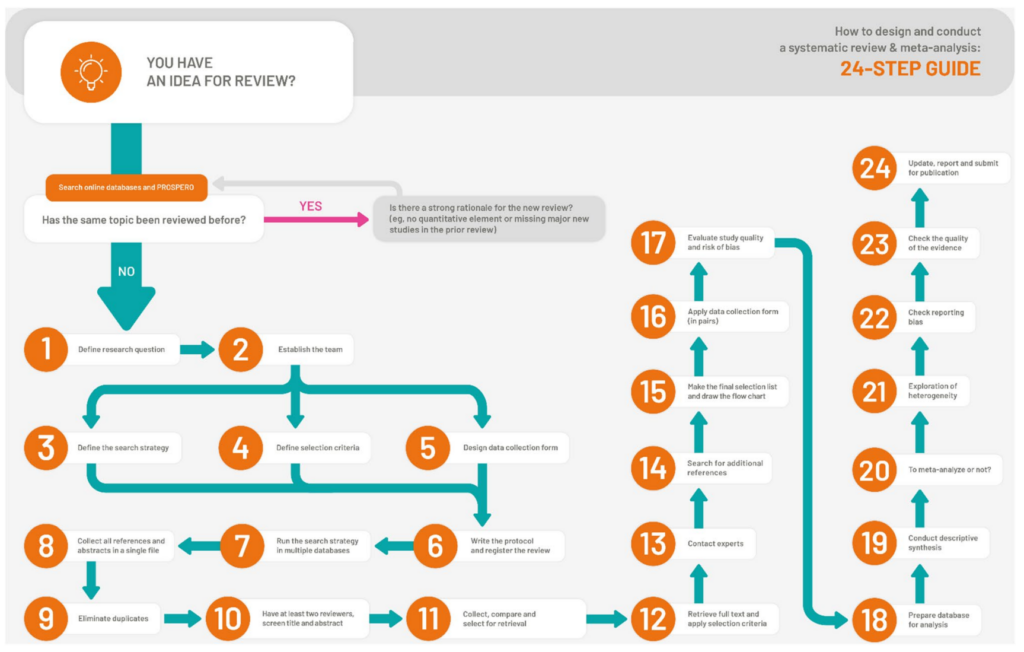This guide provides instructions and tips on best practices for conducting systematic reviews. The information presented in this guide applies to reviews conducted with or without Nested Knowledge.
Free Video Course #
If you want to learn about Systematic Review from our free course on How to Review the Medical Literature, sign up today!
1. What Are Systematic Reviews? #
A systematic review answers a defined research question by collecting and summarizing all empirical evidence that fits pre-specified eligibility criteria.
- Systematic review = study of studies
- Systematic reviews collect and summarize the literature surrounding a topic
- Systematic reviews evaluate individual studies and analyze the findings
- Systematic reviews are useful for learning about general topics and relevant research
A great way to approach the development of systematic reviews (and meta-analyses) is to break them down into smaller and more simple executable tasks. “A 24-Step Guide on How to Design, Conduct, and Successfully Publish a Systematic Review and Meta-Analysis in Medical Research” is a helpful paper that provides authors with concrete steps to follow when starting the systematic review and/or meta-analysis process.

2. Planning a Review #
You will want to carefully plan your systematic review; establish a team:
- Identify a team lead or project manager to organize project tasks and ensure that the study protocol is followed.
- Identify “independent reviewers” or team members to verify data, adjudicate study inclusion differences, and identify those that will participate in each step of the review process.
Is this review feasible?
Before you begin the process of performing a systematic review, you will want to ask the crucial question of whether your project is feasible. Does this project have the potential to lead to a publication in a peer-reviewed journal?
The first question to ask is whether there is enough literature available to actually pursue your systematic review. A quick PubMed search will allow you to assess whether papers have been published on your topic of interest. Be sure to include variations of words (for example, surgery AND surgical), British spellings, and spelled-out abbreviations. If you do not find much, you will need to broaden the scope of your review.
A second crucial question involves asking whether your topic has already been addressed in other review articles. In this case, you may want to perform a PubMed search along with the terms “systematic review” and meta-analysis.” Ultimately, you may need to narrow down your question if you find a lot of recent systematic reviews and meta-analyses.
Should you register your protocol?
Here is a template that you can use for your protocol.
Consider registering the protocol on PROSPERO:
If time permits, PROSPERO registration is highly recommended since it improves the credibility of a review. However, PROSPERO registration must be done before data extraction is started.
Here are PROSPERO registration Instructions to register your project. You will need to create an account and enter answers to these questions.
Here is an example of a completed PROSPERO registration that you can look at.
PROSPERO Tips & Warnings:
1. Make sure you have NOT begun to extract any data for your review, otherwise, you cannot register at this point.
2. PROSPERO only accepts registrations for reviews with health-related outcomes .
3. Perform a search in PubMed to verify that your specific review is an original idea.
3. Conduct Review #
Use the Nested Knowledge software to conduct a systematic review or use external methods.
4. Quality Control #
Quality control is necessary to ensure that your extracted data are accurate and your included studies are all high quality.
5. Find a Journal #
When thinking about writing the manuscript, you must find a target journal that is likely to accept your manuscript.
6. Write the Manuscript #
Begin writing up your introduction, abstract, methods, results, and discussion sections of the manuscript.
7. Format Manuscript #
All journals have formatting requirements before you can submit your materials for possible publication.
8. Submit Manuscript #
The final step in conducting a systematic review is to Tips for Submitting Your Manuscript your completed and QC’ed manuscript to the target journal.

